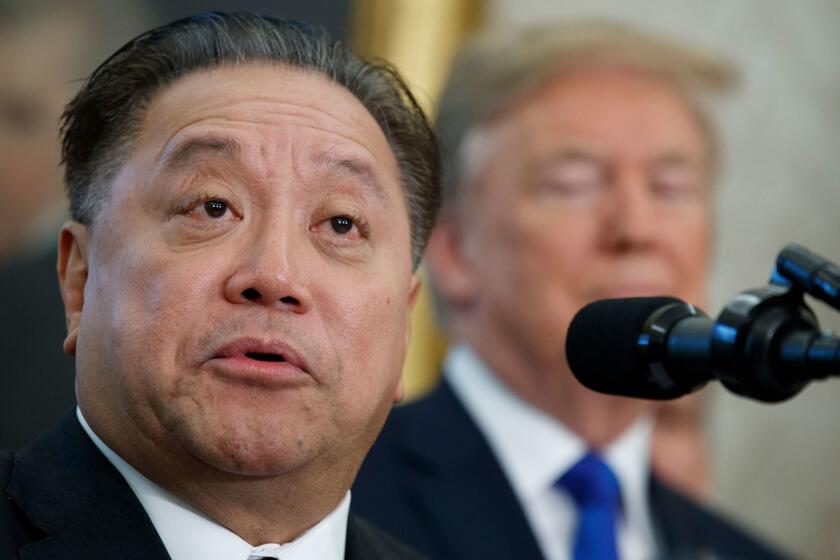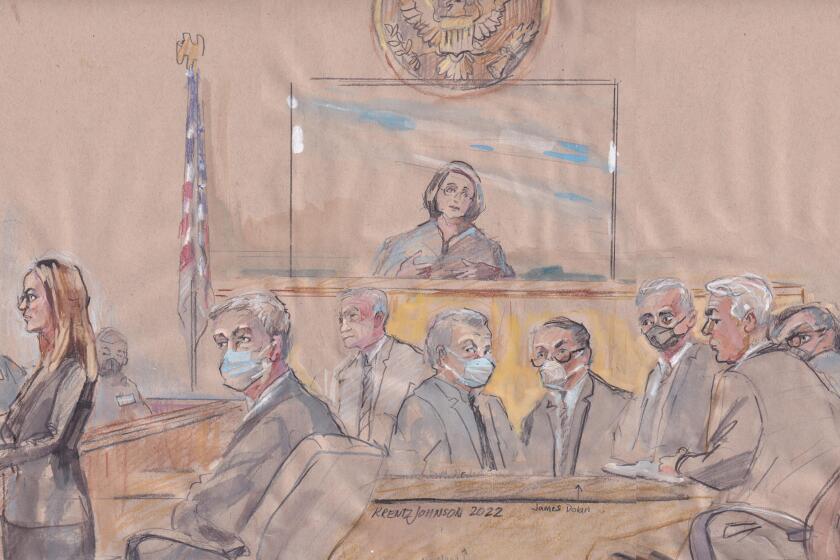4 biggest issues facing next Veterans Affairs secretary
The next person who leads the U.S. Department of Veterans Affairs will have one of the biggest jobs in America.
He or she will inherit a bureaucracy with a $182 billion budget and more than 340,000 employees at a time that promises to bring tumultuous change, including the question of whether VA medical services should be partly or wholly privatized.
The agency also carries the baggage of a serious image problem after four years of scandals about delayed health care and backlogged disability claims. It’s also responsible for leading the nation’s efforts to combat the roughly 20 suicides per day among veterans.
There’s also the challenge of meeting the diverse needs of its 6 million patients. The agency is dealing with both the Vietnam War generation, now facing the expensive illnesses of aging, and the recent wave of Iraq and Afghanistan veterans, who bring home battle-broken bodies and emotional wounds.
And the Veterans Affairs department must address dissatisfaction within its own staff: It ranks second-to-last for best places to work in the federal government
President-elect Donald Trump is said to be days away from naming his nominee, after taking more time than with other Cabinet positions to analyze the best fit to carry out his vision.
The contenders are reported to be retiring Florida Rep. Jeff Miller, outgoing chairman of the House Committee on Veterans Affairs; former Massachusetts Sen. Scott Brown; and Pete Hegseth, former head of the conservative-leaning group Concerned Veterans for America.
Former Republican presidential nominee Mitt Romney is also said to be in the running, as are retired U.S. Coast Guard Commandant Thad Allen, who was in charge of the 2010 Deepwater Horizon oil-spill response, and Adm. Michelle Howard, the Navy’s first female four-star admiral.
On the experts’ list of the four biggest issues the new VA secretary will face, there appears to be a tie for first.
Bureaucracy
Veterans advocates from various corners of the political landscape identify the VA’s middle management as the biggest roadblock to change.
VA employment boomed with the post-9/11 wars. The agency added 122,000 jobs, a 56 percent increase, between 2000 and 2013, according to a Cato Institute analysis.
Sherman Gillums, head of the organization Paralyzed Veterans of America, sees regional management in the VA’s health-care apparatus as problematic.
Administrative staff at the agency’s 21 regional health-care districts grew from 220 staffers to 1,340 by 2011, according to Gillums, who wrote a recent opinion piece on the subject titled “The One Problem That Will Make or Break Trump’s Pick for VA Secretary.”
These middle managers hold the purse strings for local VA hospitals and are supposed to provide oversight. Gillums argues that they’re overpaid and underworked and have sidestepped accountability for the VA’s recent health scandals, including the one in Phoenix, where VA officials hid long waits for medical appointments by using secret patient lists.
“Middle management is the biggest issue that needs to be cleaned up immediately, if anything else is going to change,” Gillums said in a phone interview last week. “To have that many people but not an increase in oversight, it doesn’t make sense.”
Critics have said it’s too hard to get rid of bad VA employees, and they’ve called out VA Secretary Bob McDonald for saying he fired 60 people linked to the wait-time scandal when it appears that didn’t happen.
Attempts by Congress to reduce this bureaucracy have had uneven results in recent years.
Dan Caldwell, policy director at Concerned Veterans for America, said the VA has more than the usual number of top-level people who are protected by Civil Service rules. In other words, other agencies have more appointed positions, which are filled at the pleasure of the secretary.
“It’s a very entrenched bureaucracy that has been impervious to change over the past few years, that is very invested in the current system,” Caldwell said, adding that any new rules designed to change the setup would likely be challenged in court by individual employees and organized labor.
Privatization
The movement to change the way the nation provides medical services for its veterans gained momentum with the 2014 Veterans Choice Act.
With veterans sometimes waiting months for appointments, Congress created a program that pays for patients to see outside doctors if the VA can’t schedule an internal visit within 30 days or if the distance to be traveled is too far from the patients’ home.
Trump is weighing the idea of a system in which vets can pick a combination of public and private care or simply opt for a private doctor, his transition team has said. Supporters of this approach call it greater choice, while critics see it as privatizing public health care.
Some respected veterans groups are fighting this idea and have even called for Trump to keep the current VA secretary — McDonald. They argue that a large-scale move toward private care might erode what’s now a full-service network attuned to treating veterans’ distinct needs.
“Some people pooh-pooh the idea that it’s being privatized, but what is happening is the more you pull out of that center, the harder it is for that integrated care to take place,” said Amy Fairweather, policy director for Swords to Plowshares, a veterans advocacy and service group based in San Francisco.
Others said the jury is still out whether it can work. Gillums, of Paralyzed Veterans of America, said there now appears to be an inevitability to the discussion.
“I think it’s going to be a lot harder than people think, but I think the train has left the station with (Choice Act) care. When that passed, with all the support it got from Capitol Hill, it was the first step toward evaluating whether this is a viable alternative to VA care,” he said.
Gillums added that veterans groups will want the next VA secretary to provide detailed answers about how a new system would work.
“I’m worried they are going to look at how many veterans were seen versus how many were made better off when they went to the private sector,” he said.
There is some precedent. Medicare, another large government medical program, introduced an option called Medicare Advantage.
Private health companies offer managed-care plans to people who want to opt out of traditional Medicare. It has become somewhat popular, especially in California, said John Romley, a University of Southern California economist who studies the hospital industry.
The results of that experiment are mixed, Romley said.
“There’s a very robust debate about that,” he said. “In general, we think competition is a healthy thing. It gives people choices and makes providers of services accountable for their performance.”
There are risks. The average person may not be sophisticated enough about medical issues to navigate the system and make the best choices, Romley said. Also, there have been accusations about “cream skimming,” in which private plans court the healthiest patients and leave the sicker — and thus more expensive — patients in the traditional Medicare program.
Claims backlog
Thanks in part to massive amounts of overtime work, the VA has succeeded in making a large dent in its backlog of disability claims.
The total is now at just over 93,000 claims still waiting more than 125 days without a decision — down from a 2013 high of more than 600,000 in the so-called backlog.
But let’s not call that victory, said Caldwell of Concerned Veterans for America. He and others also said there’s a big challenge ahead to continue modernizing how the labyrinthine claims process works.
“Sending documents back and forth via courier or mail — it’s astounding, in the digital age, that they are still operating large parts of the claims process in way that is not that much that different than in 1980,” Caldwell said.
However, there’s some concern in the veterans community that the age of automation brings dangers, as complicated cases require human judgment to be handled fairly and correctly.
More clinical resources
Despite its big staffing increases, the VA still faces challenges finding and keeping enough medical professionals.
Paralyzed Veterans of America has called for 1,000 more bedside nurses for spinal-care units. Meanwhile, the turnover rate for registered nurses is high in some regions, including in San Diego County.
Additionally, just as one in five young veterans struggles with post-traumatic stress disorder, the nation is in the middle of a shortage of psychiatrists.
“One of the biggest things for the new VA secretary, and frankly I think for the new administration, is to really convey that they understand the seriousness of mental health injuries,” said Nathan Fletcher, a San Diego Iraq war veteran and former state assemblyman who started the Three Wise Men foundation to help returning vets
The VA recently launched programs to woo more psychiatrists. Those include better salaries and college loan repayment programs.
Military Videos


D-Day paratrooper from Coronado jumps again in France — at age 96

Remembering war's fallen, one name at a time

Video: Navy's newest vessel sails into San Diego and a new future in surface warfare

Video: U.S. Navy files homicide charges over warship collisions

Stopping Marine hazing

Video: U.S. Navy Air Crew Grounded After Creating Vulgar Sky Drawing

Navy says Asia Pacific ship collisions were avoidable

Hundreds of recruits get sick at Marine boot camp

Cutler Dawson Talks Navy Federal
Get Essential San Diego, weekday mornings
Get top headlines from the Union-Tribune in your inbox weekday mornings, including top news, local, sports, business, entertainment and opinion.
You may occasionally receive promotional content from the San Diego Union-Tribune.






